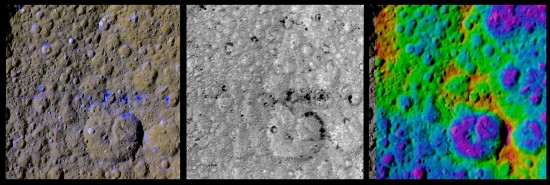
Three views of Rhea’s equatorial zone. (L) infrared, green and ultraviolet filters. (M) ratio of infrared to ultraviolet wavelengths, indicating blueness. (R) color-coded topography: purple is 0 elevation and pink is 6 kilometers. Credit: NASA/JPL/SSI/LPI
Jul 1, 2015
Saturn’s moons sport colorful bands.
Mars is a faint yellowish-red color when seen with the naked eye, and its rusty surface hue is visible through the lenses of robotic rovers traveling across its landscape. Iapetus, one of Saturn’s moons, has a reddish-black deposit covering one hemisphere. Hyperion’s surface is also dusted with what appears to be the same “soot” that covers Iapetus. The material piles into drifts inside some of Hyperion’s deeper craters. Mimas, Enceladus, Rhea, Dione, and Tethys are also red to some degree. Except for Mimas, they are redder on their trailing hemispheres and the color tends to be more intense in the centers of their disks. Although the leading faces of the moons are also red, it is not as strong.
NASA scientists admit that the pattern on both hemispheres is “difficult to explain”, since only one or the other would normally be affected. Bombardment by a train of meteors, or particles from Saturn’s rings, should accumulate on the leading hemispheres.
However, it is most likely a plasma, in the form of high energy ions and electrons that is flowing into the moons from their supercharged electrical parent that is contributing to the coloration. Planetary scientists now believe that Saturn’s moons are even more colorful than red, alone.
Material from Enceladus seems to leave a brighter, blue pattern in certain wavelengths. Also, the bluish dust on Enceladus, itself, indicates that it is experiencing “fallback” from its energetic emissions. The well-known plumes on Enceladus also appear to paint Tethys, Dione, and Rhea. However, scientists do not know why the leading hemispheres of these moons are a rusty red.
In an Electric Universe, Saturn moves within the plasmasphere of the Sun and interacts with the Sun’s electric field. Since planets and moons in the Solar System are charged bodies that are not isolated in space, it is to be expected that they transact electrically with each other.
Saturn’s moons emit ionic plumes because of their position in Saturn’s circuit. More than one quarter of Phoebe’s mass has been removed and has been distributed throughout the Saturnian system because of its electrical connection to Saturn. The reddish-black soot covering the other inner moons of Saturn most likely came from Phoebe.
The dwarf planet Haumea revolves around the Sun in an orbital path out past Neptune and into the farthest reach of Pluto’s orbit. Hubble Space Telescope images of Haumea suggest the presence of a dark spot on its dimmer side. The spot also has a reddish tint that could be due to a concentration of compounds that reflect red light.
A previous Picture of the Day considered other remote objects called Centaurs. Along with Mars and the moons under discussion, they are also colorful. Some are green and some are blue, but the primary color is a brick or rust-red.
Centaurs are colorful because they might have been ejected out of different gas giant planets. Optical instruments show that Neptune has a green color, Uranus a blue, Saturn a pale yellow and Jupiter a rusty red. Could the centaurs be exemplifying their parental traits? Could that same familial relationship also provide the reason for colorful moons?
The Electric Universe suggests that colored planets and moons are because of different chemical compositions. Stars are formed when cosmic Birkeland currents twist around one another, creating z-pinch regions that compress plasma. Laboratory experiments show that such compression zones are likely candidates for star formation.
Stars that are under extreme electrical stress might split into two or more daughter stars, thereby reducing each one’s electrical potential. Further activity may result in the ejection of stars that are not energetic enough to glow, so the resulting objects will be gas giant planets in dark mode. Gas giants, in turn, will eject rocky objects from their plasma cores if there is a disequilibrium. Those smaller bodies will retain the composition they inherited from whichever gas giant gave them birth.
All of the daughter objects in orbit about their parents are connected to them in vast electric circuits. Those circuits were once energized to an awesome extent and carried material from one to another along cosmic electrical transmission lines called Birkeland currents. The charged nuclei of ionized iron, oxygen, and sulfur traveled along those currents between the celestial bodies in an exchange of elements.
Stephen Smith












